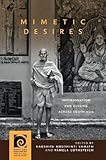Mimetic Desires : Impersonation and Guising across South Asia / ed. by Pamela Lothspeich, Harshita Mruthinti Kamath.
Material type: TextSeries: Music and Performing Arts of Asia and the PacificPublisher: Honolulu : University of Hawaii Press, [2022]Copyright date: ©2023Description: 1 online resource (300 p.) : 29 b&w illustrationsContent type:
TextSeries: Music and Performing Arts of Asia and the PacificPublisher: Honolulu : University of Hawaii Press, [2022]Copyright date: ©2023Description: 1 online resource (300 p.) : 29 b&w illustrationsContent type: - 9780824894108
- 792.02/80954 23/eng/20220914
- PN2071.I47 M56 2023eb
- online - DeGruyter
| Item type | Current library | Call number | URL | Status | Notes | Barcode | |
|---|---|---|---|---|---|---|---|
 eBook
eBook
|
Biblioteca "Angelicum" Pont. Univ. S.Tommaso d'Aquino Nuvola online | online - DeGruyter (Browse shelf(Opens below)) | Online access | Not for loan (Accesso limitato) | Accesso per gli utenti autorizzati / Access for authorized users | (dgr)9780824894108 |
Frontmatter -- CONTENTS -- A NOTE ON TRANSLITERATION -- LIST OF FIGURES -- Introduction -- CHAPTER 1 Public Impersonators GENDER, CASTE, AND SOCIAL ONTOLOGY IN THE MARATHI VERNACULAR MOMENT -- CHAPTER 2 Racial Impressions, Capital Characters DAVE CARSON BROWNFACES THE EMPIRE -- CHAPTER 3 Remembering the Hunterwali’s Whip THE GHOSTS OF FEARLESS NADIA AND HER MANY GUISES -- CHAPTER 4 In Gandhi’s Guise -- CHAPTER 5 Playing the Yogi THE MAKING OF SWAMI BABA RAMDEV -- CHAPTER 6 The Freedom to Dance PERFORMANCE AND IMPERSONATION IN LAGAN -- CHAPTER 7 Mediatizing “Fake” Khwaja Siras THE LIMITS OF IMPERSONATION -- CHAPTER 8 “We Are Better than the Women” UNDERSTANDING THE POPULARITY OF FEMALE ARTISTS IN KERALA -- CHAPTER 9 Cosplay, Fandom, and the Fashioning of Identities at Comic Con India -- CHAPTER 10 Possessed Impersonation DIVINE MIMESIS IN MALABAR -- CHAPTER 11 Divine Embodiment in the Theatre of Ramlila -- CHAPTER 12 Resisting Brahminical Patriarchy in Kuchipudi Dance THE STORY OF HALEEM KHAN -- CONTRIBUTORS -- INDEX
restricted access online access with authorization star
http://purl.org/coar/access_right/c_16ec
Through an exploration of subjects such as Gandhi impersonators, “God-men,” performance artists, and participants in ritual enactments of sacred stories through dance and theatre, Mimetic Desires makes an intervention toward understanding the phenomenon of impersonation and guising in South Asia and the world. This volume defines impersonation as the temporary assumption of an identity or guise in performance that is perceived to be not one’s own, regardless of whether this assumption is deliberate, intentional, and conscious or not. Interrogating the legitimacy of the purported dialectic between the “real/original” and “fake/dupe,” Mimetic Desires refutes any ordering of identity along the lines of a binary or dichotomy that presupposes the myth of an original identity. Guising captures sartorial and kinetic play more generally. By peeling back the layers of performative masks to reveal the process of the masquerade itself, we can see that those with the most social capital are often those with the most power and opportunities to impersonate “up”—and “down”—social hierarchies. The twelve chapters in Mimetic Desires disclose sites and processes of socio-political power facilitated by normative markers of social status relating to race, ethnicity, gender, caste, class, and religion—and how those markers can be manipulated to express and enhance individual and group power. The first comprehensive study to focus on impersonation in South Asia, Mimetic Desires expands on previous scholarship on impersonation and guising in vernacular theatre, dance, public processions, and religious ritual. It is particularly in conversation with the robust scholarship on gender performance and trans-kothi-hijra engagement in theatrical and dance forms in South Asia. Mimetic Desires explores some of the contexts and forms of impersonation in South Asia, with its remarkable array of performing arts, to gain insight into the very human and "idian practices of impersonation and guising.
Mode of access: Internet via World Wide Web.
In English.
Description based on online resource; title from PDF title page (publisher's Web site, viewed 29. Mai 2023)


